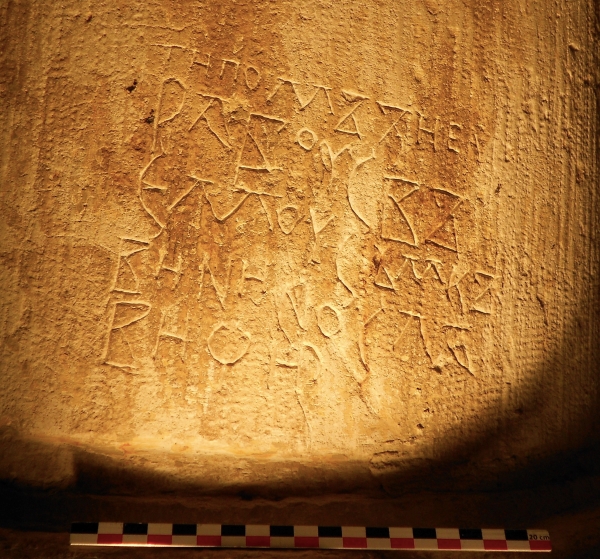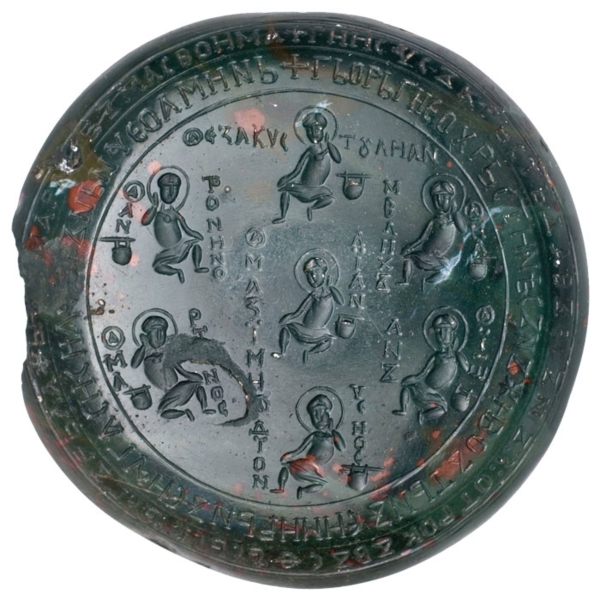

The East Slavic Epigraphy corpus includes inscriptions of the 11th-15th centuries.
Epigraphy is a discipline dealing with the study of inscriptions on surfaces that are not, as a rule, specifically designed for a message. Epigraphic monuments differ from both traditional (livresque) texts and documents on parchment, paper or birch bark. The field of epigraphy usually does not include replicated inscriptions minted on coins (numismatics) and stamped on seals (sphragistics). The word epigraphy collectively refers to epigraphic monuments themselves.
In medieval Rus', inscriptions were left on the walls of churches (scratched inscriptions, so-called graffiti, are perhaps the most numerous), on dedicated monuments (stones, crosses), on various church and household objects. Inscriptions are found during archaeological excavations, studies of medieval buildings, and some of them have been kept in various collections for centuries.
The inscriptions included into the corpus come not only from the territory of Eastern Europe. Travelers from Polatsk, Kyiv or Novgorod left them as far from Rus' as in Lucca, Saint-Gilles, Constantinople or Bethlehem.
Most of the extant inscriptions are brief and formulaic, often they are captions to a church image or messages like "Written by such-and-such" or "Lord, help to such-and-such". But there exist also long, extended texts, unusual in content. Even the shortest inscriptions may contain unique names or interesting linguistic phenomena. Many Old East Slavic inscriptions have a very early date, predating not only the surviving traditional manuscripts, but also the majority of birchbark letters. Epigraphy is a valuable source both on the history of everyday Old East Slavic speech and on the functioning of church, literary and folklore texts.
Thus, epigraphy may inform the following disciplines:
- history of language and writing;
- history of medieval society, everyday life, clarification of the chronology of historical events;
- history of cultural contacts (borrowed expressions, evidence of traveling);
- study of ancient literature, worship, folklore;
- history of art. including architecture, jewelry, fresco or icon painting.
The bulk of the collection of epigraphic texts within the Russian National Corpus is made up of inscriptions collected in the epigraphica.ru database, which is being developed within the framework of the same project. Authoritative publications accepted in this database as the main versions of the text, as well as corrections to the readings made by the authors of the database themselves, are used. Only previously published texts written in Slavic languages and containing alphabets or numerals were selected for the corpus.

The corpus features word-by-word morphological annotation with homonymy resolved. It is based on the same standard of lemma presentation and morphological annotation as in the Old East Slavic corpus. This is explained by the early date of most of the texts included in the corpus. A search is also available for lemma in the Late Old East Slavic form.
Fragments of word forms, hypothetical interpretations and alternative parsings are marked with special tags. As in the Birchbark letters corpus, many texts have survived in a fragmented state.
Again not unlike the Birchbark letters corpus, the Inscriptions corpus is a parallel one. For most inscriptions their translations into Russian are aligned, available for a morphological search as well. The translations are either taken from the most authoritative publications of the inscriptions in question or compiled by the team of the epigraphica.ru database.
All the texts are provided with multi-level metatextual markup, indicating the carrier of the inscription (e.g., church walls or an object), the type of this carrier, the material (plaster, stone, metal, wood, bone, cloth), the technique of inscription (graffito, painting, carving, casting, soldering), the category and genre of the text, the locality where the inscription was found (though written not necessarily there), the alphabet (Cyrillic or Glagolitic), the extent to which the inscription survives, and its precise or approximate date.
The Glagolitic inscriptions included in the corpus are given in a Cyrillic transliteration. Encrypted inscriptions and monograms are rendered as decipherment or reconstruction. They can be seen in their original form at epigraphica.ru.
From the meta-information of each text, a hyperlink leads to the epigraphica.ru database, where more detailed data on the text in question (including various competing interpretations, commentaries, bibliographic data), as well as photographs and drawings of the inscriptions, are available.
Photographs and drawings of inscriptions are also directly available in the corpus results. By default, preview images are displayed in the concordance: photographs are shown on the left, and drawings are on the right. Clicking on an image opens it in full-screen mode, where users can zoom in or out on the drawings and photographs and download them as needed. In KWIC mode and when selecting a subcorpus, images can only be viewed in full-screen mode by clicking the icon to the right of the text header. There is a setting in the menu to hide images. This option is saved in the user’s browser, so upon returning to the corpus, the settings will remain, and the results will be displayed without images.
The texts of the East Slavic Epigraphy make part of the Panchronic corpus, available for searching together with other historical texts.
The primary filling of the epigraphica.ru database, including meta-information, was carried out by the team led by Alexei Gippius (Savva Mikheev, Dmitri Sitchinava, Anton Dyshkant, Daniil Ignatiev, Maria Drobysheva, Dmitri Krylov, Svetlana Lashchuk, Kristina Pokrovskaya, Nadezhda Sedukova, Anna Fitiskina).
Daniil Ignatyev and Dmitri Sitchinava performed data export for the corpus, and morphological markup was done by Sitchinava (using the Morphy program by Timofey Arkhangelsky).
Check out the list of scientific publications on the East Slavic Epigraphy (Inscriptions) Corpus via the link: https://ruscorpora.ru/s/ax5mP. In the Publications section, use filters to find other types of publications about the corpus.
Updated on 25.01.2025
